Hopi Pueblo Cottonwood Root Hú Katsina Doll - C3843G
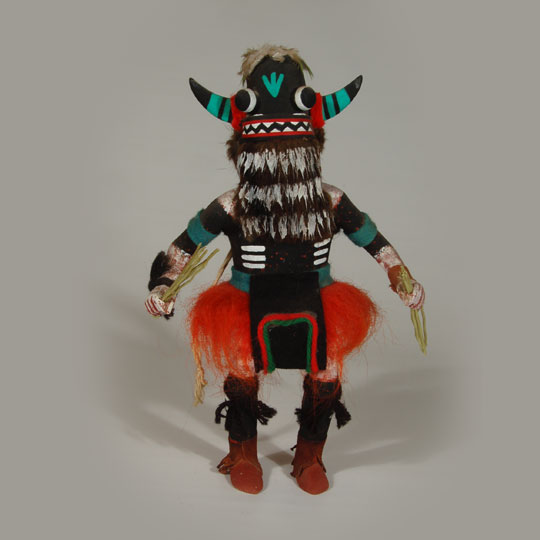 "When the time approaches for whipping the children during ceremonies in the kiva, a signal is given and the three Kachinas: the Crow Mother and her two sons, the Hú Kachinas, come rushing toward the kiva. There they make four circuits of the hatchway creating as much noise as possible by beating the hatchway with their whips and bounding about to make their rattles sound. At the end of the fourth circuit they enter the kiva and take their positions north of the fireplace. The initiates are brought forward by their ceremonial god-parents and placed on the sand painting. The Hú Kachinas advance and give them four strokes with their yucca whips. As each candidate is struck the yucca whip is waived through the air with a wicked swish. This is a gesture of purification.
"When the time approaches for whipping the children during ceremonies in the kiva, a signal is given and the three Kachinas: the Crow Mother and her two sons, the Hú Kachinas, come rushing toward the kiva. There they make four circuits of the hatchway creating as much noise as possible by beating the hatchway with their whips and bounding about to make their rattles sound. At the end of the fourth circuit they enter the kiva and take their positions north of the fireplace. The initiates are brought forward by their ceremonial god-parents and placed on the sand painting. The Hú Kachinas advance and give them four strokes with their yucca whips. As each candidate is struck the yucca whip is waived through the air with a wicked swish. This is a gesture of purification.
Hopi Pueblo Cottonwood Root Tunei-nili Katsina Doll - C3843H
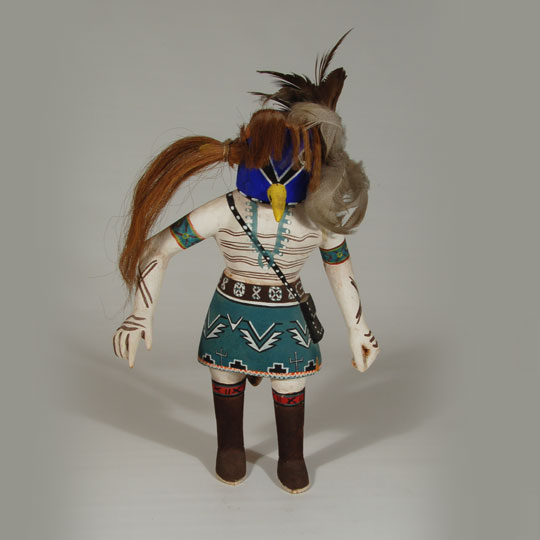 Tunei-nili is a Navajo-derived katsina. He is the individual who looks after the Navajo or Tasap Katsinas and is usually called a side dancer for them. He may not always appear with the Tasap, however. He was inspired by the Navajo Rain Gods the Tone-nili, who appear on the sixth day of the Navajo Yeibichai Ceremony. The name Tunei-nili Bitzai means "little wash" or "little river grandfather." He sometimes appears with the Velvet Shirt Katsinas also.
Tunei-nili is a Navajo-derived katsina. He is the individual who looks after the Navajo or Tasap Katsinas and is usually called a side dancer for them. He may not always appear with the Tasap, however. He was inspired by the Navajo Rain Gods the Tone-nili, who appear on the sixth day of the Navajo Yeibichai Ceremony. The name Tunei-nili Bitzai means "little wash" or "little river grandfather." He sometimes appears with the Velvet Shirt Katsinas also.
Hopi Pueblo Susöpa - Cricket Katsina Doll - C3843F
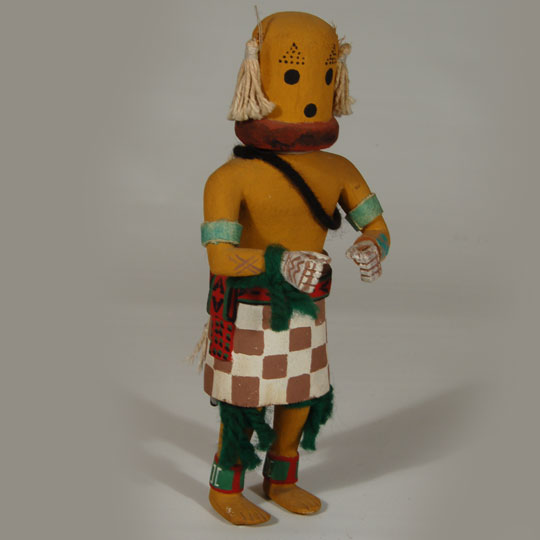 The Cricket Katsina (Susöpa) appears as a racer, although many Hopi will say that he appears only at night in the kivas. This seems to be a difference among villages. Usually this katsina appears with a black bandolier over his chest, represented here by a black yarn strip. He is sometimes pictured with a tuff of small feathers in place of ears. The ears on this carving are made from string. Two bundles of grasses point upward from the ears but they are missing from this carving.
The Cricket Katsina (Susöpa) appears as a racer, although many Hopi will say that he appears only at night in the kivas. This seems to be a difference among villages. Usually this katsina appears with a black bandolier over his chest, represented here by a black yarn strip. He is sometimes pictured with a tuff of small feathers in place of ears. The ears on this carving are made from string. Two bundles of grasses point upward from the ears but they are missing from this carving.
Hopi Circular Pottery Tile with Sun Katsina Face by Darlene Nampeyo - C3843o
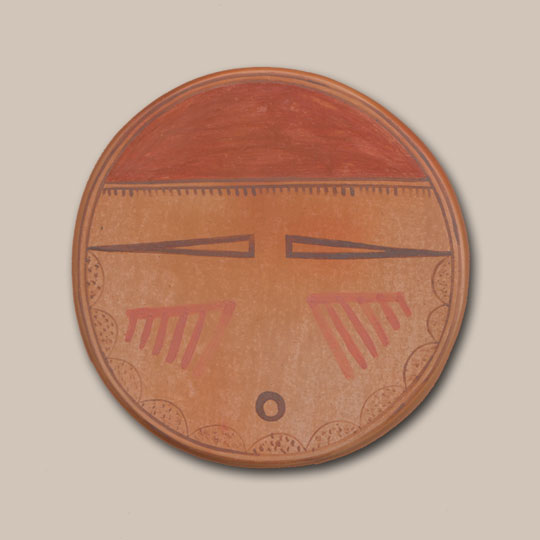 Darlene James Nampeyo, who passed away in 2012 at the age of only 56 years, was a granddaughter of Rachel Nampeyo, great granddaughter of Annie Healing Nampeyo and great-great granddaughter of Nampeyo of Hano. She had been a constant winner of awards at the Museum of Northern Arizona's annual Hopi Show and was awarded the Fannie Nampeyo Memorial Award, Best of Division at the Scottsdale Native American Indian Cultural Foundation Show, and seven consecutive Santa Fe Indian Marketawards.
Darlene James Nampeyo, who passed away in 2012 at the age of only 56 years, was a granddaughter of Rachel Nampeyo, great granddaughter of Annie Healing Nampeyo and great-great granddaughter of Nampeyo of Hano. She had been a constant winner of awards at the Museum of Northern Arizona's annual Hopi Show and was awarded the Fannie Nampeyo Memorial Award, Best of Division at the Scottsdale Native American Indian Cultural Foundation Show, and seven consecutive Santa Fe Indian Marketawards.
Hopi Pueblo Pottery Tile with Cow Katsina Image by Alberta Adams - C3843J
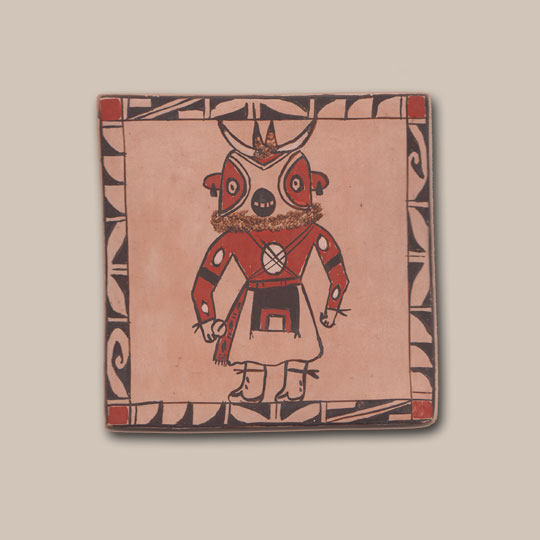 Alberta Adams is listed in Gregg Schaaf's book Hopi-Tewa Pottery 500 Artist Biographies but only the statement "active 1980-present: polychrome wedding vases, bowls" is included for her. She is not mentioned at all in Messiers' book Hopi & Pueblo Tiles so there seems to be little biographical information on her as a potter even though she is acknowledged as having produced since 1980. She is from Hopi Pueblo in Arizona.
Alberta Adams is listed in Gregg Schaaf's book Hopi-Tewa Pottery 500 Artist Biographies but only the statement "active 1980-present: polychrome wedding vases, bowls" is included for her. She is not mentioned at all in Messiers' book Hopi & Pueblo Tiles so there seems to be little biographical information on her as a potter even though she is acknowledged as having produced since 1980. She is from Hopi Pueblo in Arizona.
Hopi Pueblo Tile with Three Horn Katsina Image by Alberta Adams - C3843K
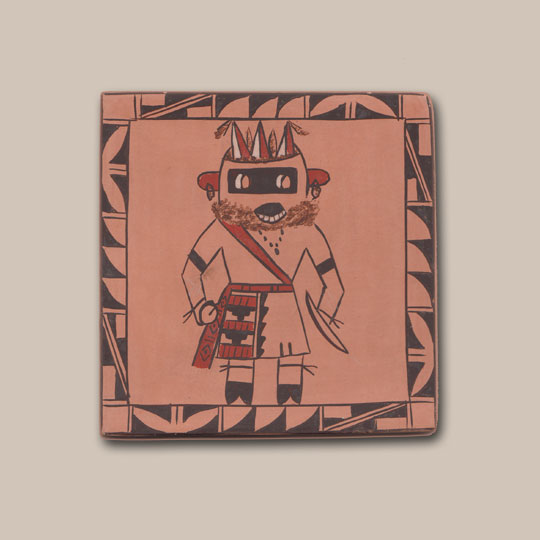 The Payik'ala - Three Horn Katsina appears in the Mixed Dance. Barton Wright says that there are Hopi who remember this Katsina being danced at Third Mesa before 1906. This is a good representation of this Katsina, and it is in very good condition. Harold S. Colton states that it was introduced from Zuni to First Mesa in 1921.
The Payik'ala - Three Horn Katsina appears in the Mixed Dance. Barton Wright says that there are Hopi who remember this Katsina being danced at Third Mesa before 1906. This is a good representation of this Katsina, and it is in very good condition. Harold S. Colton states that it was introduced from Zuni to First Mesa in 1921.
The Kachina has a black band across his eyes, three horns sticking upward from his mask and is bare chested. He carries a bow in his left hand and a gourd rattle in his right. The artist has presented a very good likeness of the Katsina.
Oil Painting “Red Rocks—Near Gallup” by Joseph R. Willis - C3835
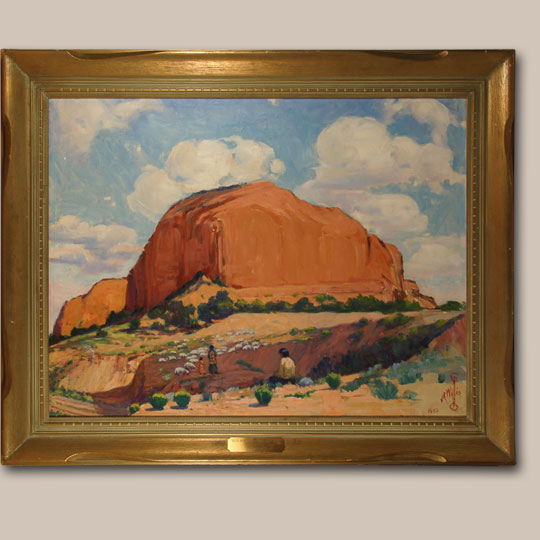 Joseph R. Willis (1876-1960) is best known for his Indian photographs and paintings and southwestern landscapes. Before moving to the Southwest, he had earlier traveled throughout the Southeastern part of the United States where he took advantage of the beauty of the region to paint many portraits and landscapes.
Joseph R. Willis (1876-1960) is best known for his Indian photographs and paintings and southwestern landscapes. Before moving to the Southwest, he had earlier traveled throughout the Southeastern part of the United States where he took advantage of the beauty of the region to paint many portraits and landscapes.
In 1917, he settled in Gallup, New Mexico, where he established a photography studio. Then in 1931, he moved to Albuquerque where he settled for the remainder of his life. After leaving Gallup, Willis spent more time painting than photographing. His style was realism, not unexpected since his eye was trained for photography. His paintings are not photo realistic, but are softer in presentation.
Santa Clara Pueblo Red Sgraffito Pictorial Jar by Corn Moquino - C3841C
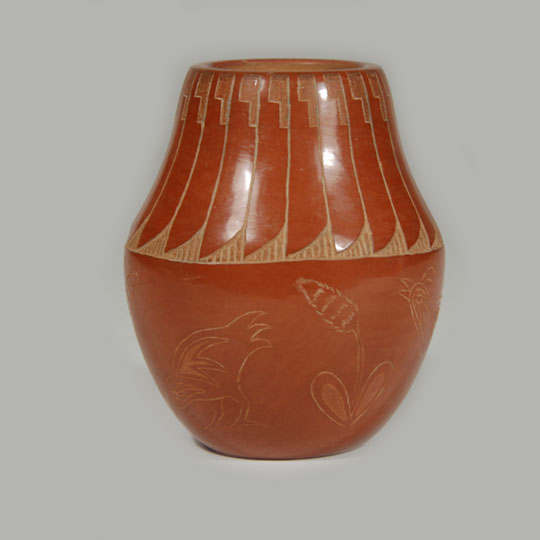 Corn Moquino is of Zia and Hopi heritage. He married into Santa Clara Pueblo and has been making Santa Clara style pottery since around 1963. He is one of the earlier potters to employ sgraffito style carving.
Corn Moquino is of Zia and Hopi heritage. He married into Santa Clara Pueblo and has been making Santa Clara style pottery since around 1963. He is one of the earlier potters to employ sgraffito style carving.
Painting of a San Juan Pueblo Dancer by Poquin Tahn - C3839F
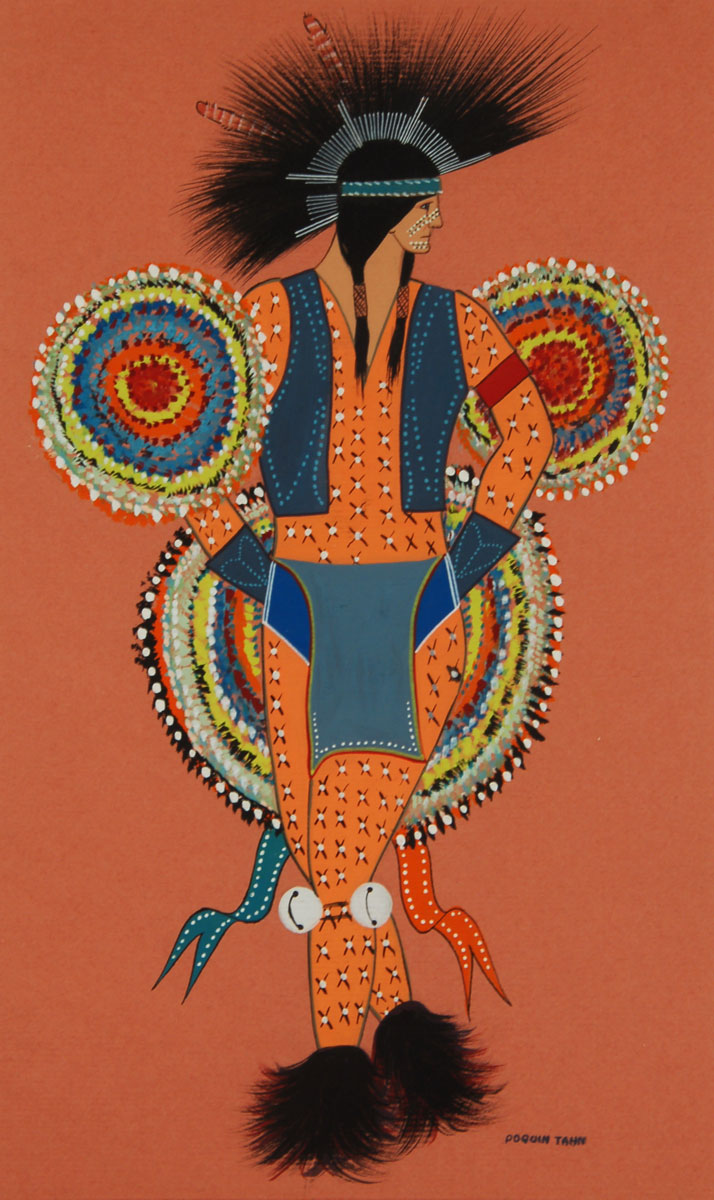 Ascensión Trujillo was from San Juan Pueblo (now Ohkay Owingeh). Like most of his contemporaries, he attended the Santa Fe Indian School, however, after the departure of Dorothy Dunn, so his work is not of The Studio style. He continued his education at the University of New Mexico.
Ascensión Trujillo was from San Juan Pueblo (now Ohkay Owingeh). Like most of his contemporaries, he attended the Santa Fe Indian School, however, after the departure of Dorothy Dunn, so his work is not of The Studio style. He continued his education at the University of New Mexico.
Clara Lee Tanner stated that he "painted rather extensively at the Indian School, featuring native dances. He demonstrated potentials in good and clean outlines, modeling in lines, and in a pleasing handling of color; sometimes he produced a facial type which suggests the work of Tonita Peña."
Painting of Hopi Chakwaina Katsina by Oswald Fredericks - C3839i
 It was never the intent of the Hopi to share their secrets with the White culture as there generally was a distrust by the Hopi of the White. The Hopi villages were thrust into turmoil in the early 20th century when the villages split among those who believed it was wise to follow the government's orders to send their children to white man's schools and those who were against. However, in the late 1950s Oswald White Bear Fredericks convinced Fredrick Howell, director of the Charles Ulrick and Josephine Bay Foundation, to underwrite a history of the Hopi people. Howell approved the idea and, eventually, Frank Waters was chosen as the writer to work with White Bear.
It was never the intent of the Hopi to share their secrets with the White culture as there generally was a distrust by the Hopi of the White. The Hopi villages were thrust into turmoil in the early 20th century when the villages split among those who believed it was wise to follow the government's orders to send their children to white man's schools and those who were against. However, in the late 1950s Oswald White Bear Fredericks convinced Fredrick Howell, director of the Charles Ulrick and Josephine Bay Foundation, to underwrite a history of the Hopi people. Howell approved the idea and, eventually, Frank Waters was chosen as the writer to work with White Bear.
Black-on-white Miniature Acoma Pueblo Olla by Delores Juanico - 25909
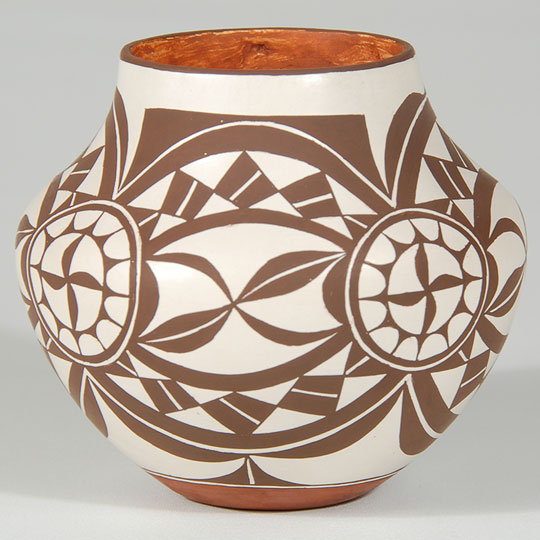 Delores Juanico is a daughter of Marie S. Juanico (1937 - ) who was her mentor. Marie learned pottery principals from her mother, Delores Sanchez, who lived to the age of 103. Young Delores carries on the tradition from her grandmother and mother of making the finest Acoma pottery. Her construction is traditional to Acoma pottery and the vessel walls are amazingly thin and consistent throughout. The design was painted to absolute perfection. Each line is thin and precise, and the application of the fill-in paint is consistent in texture.
Delores Juanico is a daughter of Marie S. Juanico (1937 - ) who was her mentor. Marie learned pottery principals from her mother, Delores Sanchez, who lived to the age of 103. Young Delores carries on the tradition from her grandmother and mother of making the finest Acoma pottery. Her construction is traditional to Acoma pottery and the vessel walls are amazingly thin and consistent throughout. The design was painted to absolute perfection. Each line is thin and precise, and the application of the fill-in paint is consistent in texture.
Pair of Nataska Katsinas “Whipping Kachinas” by Raymond Naha - C3839G
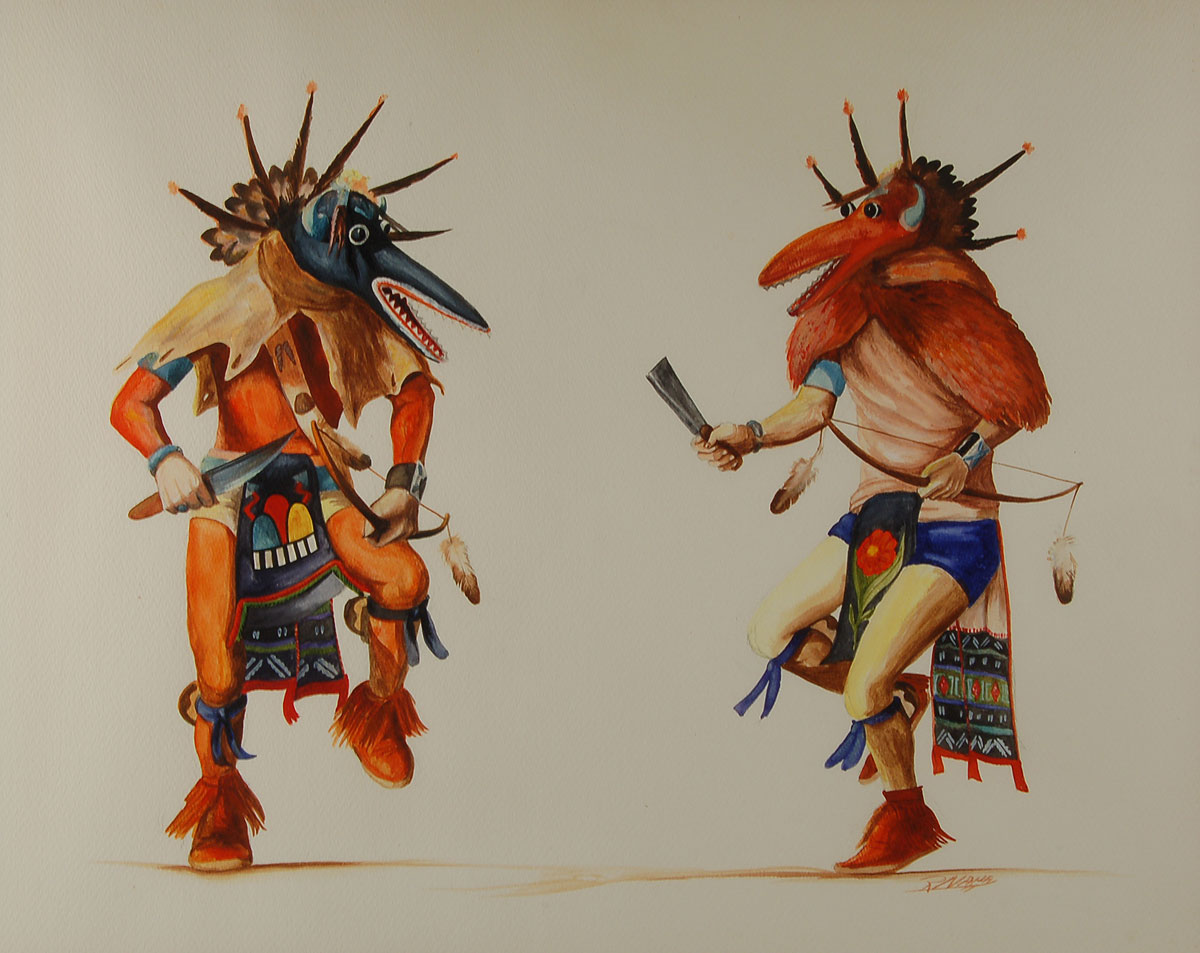 Raymond Naha was a Hopi-Tewa Indian from the village of Polacca at First Mesa. He attended the Polacca Day School and then Oraibi High School where he studied for a year under the tutelage of Fred Kabotie. Naha had a natural talent for painting and was encouraged by Kabotie to pursue his interest. Under his own initiative Naha took several correspondence courses and attended the Phoenix Indian School. As so many others, he served four years in the Army during World War II.
Raymond Naha was a Hopi-Tewa Indian from the village of Polacca at First Mesa. He attended the Polacca Day School and then Oraibi High School where he studied for a year under the tutelage of Fred Kabotie. Naha had a natural talent for painting and was encouraged by Kabotie to pursue his interest. Under his own initiative Naha took several correspondence courses and attended the Phoenix Indian School. As so many others, he served four years in the Army during World War II.
Tesuque (Te Tsu Geh Oweenge) Pueblo Bi-chrome Painted Rain God - C3618E
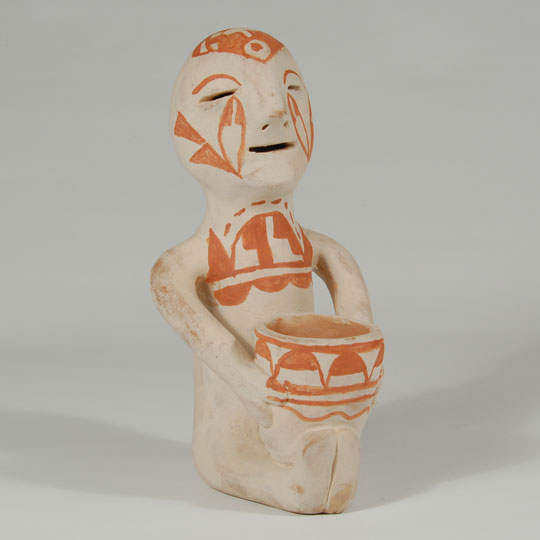 This figurine is most likely from the 1960 decade or slightly later. That was a period following the original use of all natural pigment, which was then followed by the use of bright poster paints. "After the war,pottery making gradually was revived. Bright watercolors became more available. Many Tesuque potters painted their pots with the bright colors." According to Ignacia Duran "People really went for those colored pots. For retail sales under the portal, we put more color on our pots and more action into our figures. Then, one day some people came and said they didn't want us to use the watercolor paints anymore." She said that most of the potters abandoned the bright watercolor paints for more subdued natural colors." Schaaf 2000, 260
This figurine is most likely from the 1960 decade or slightly later. That was a period following the original use of all natural pigment, which was then followed by the use of bright poster paints. "After the war,pottery making gradually was revived. Bright watercolors became more available. Many Tesuque potters painted their pots with the bright colors." According to Ignacia Duran "People really went for those colored pots. For retail sales under the portal, we put more color on our pots and more action into our figures. Then, one day some people came and said they didn't want us to use the watercolor paints anymore." She said that most of the potters abandoned the bright watercolor paints for more subdued natural colors." Schaaf 2000, 260
Micaceous Rain God Figurine from Tesuque Pueblo by Ignacia Duran - C3618D
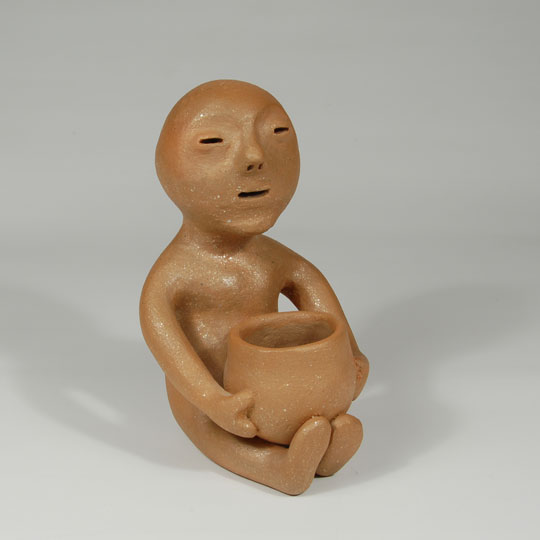 "Ignacia was among the potters who made the famous Tesuque Muna. 'Anastasia Romero Vigil was one of the first to make [Muna] Rain Gods. [By the 1920s and 30s] everyone use to make Muna. We made hundreds every week. The traders use to come every Friday' [to buy the Muna and other pottery]." Ignacia Duran in Schaaf 2000; 260
"Ignacia was among the potters who made the famous Tesuque Muna. 'Anastasia Romero Vigil was one of the first to make [Muna] Rain Gods. [By the 1920s and 30s] everyone use to make Muna. We made hundreds every week. The traders use to come every Friday' [to buy the Muna and other pottery]." Ignacia Duran in Schaaf 2000; 260
Black Carved Pottery Jar with Design Band by Margaret Tafoya - C3630
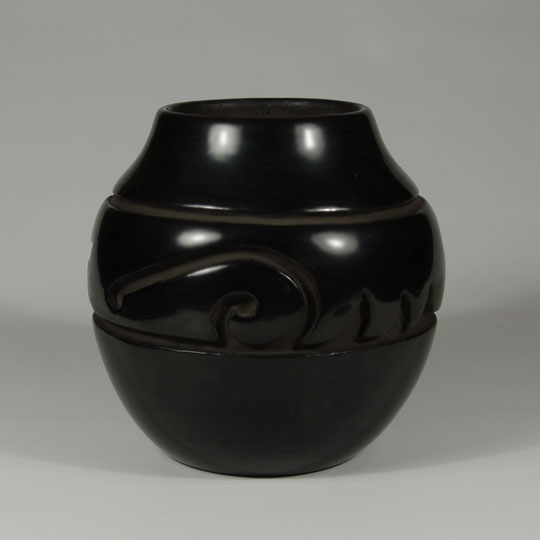 There were few potters at Santa Clara Pueblo who were as well-known as Margaret Tafoya during the 20th century. She was the mother of a talented family of potters and the entire family spent summers at the Royal Gorge near Canon City, Colorado, where they would demonstrate for tourists. Margaret was adept at making very large jars or very small jars. She produced an outstanding burnish and beautiful black firing. There were no mistakes in her work.
There were few potters at Santa Clara Pueblo who were as well-known as Margaret Tafoya during the 20th century. She was the mother of a talented family of potters and the entire family spent summers at the Royal Gorge near Canon City, Colorado, where they would demonstrate for tourists. Margaret was adept at making very large jars or very small jars. She produced an outstanding burnish and beautiful black firing. There were no mistakes in her work.
Watercolor Painting of a Female Yellow Hornet by Oswald Fredericks - C3626B
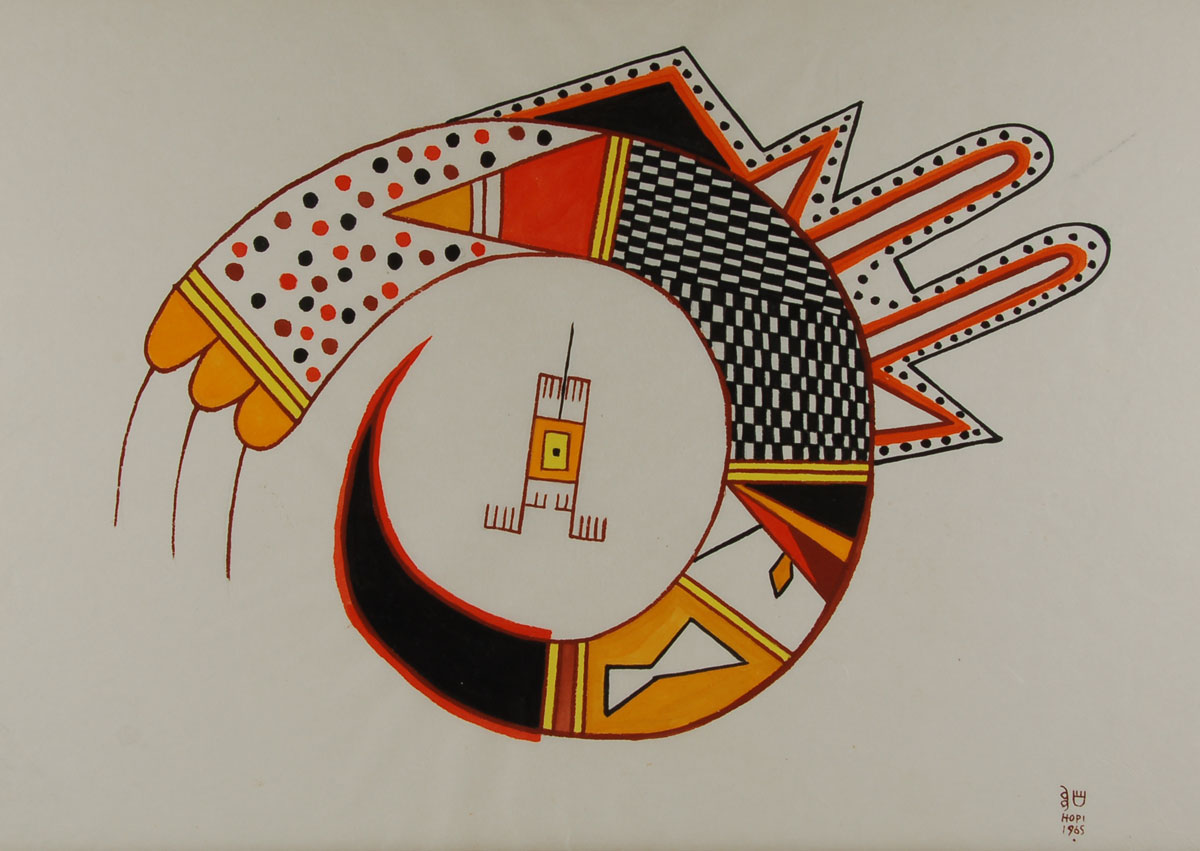 White Bear (Oswald Fredericks) spent most of his life as a Hopi artist and story teller working for various youth organizations. One of his accomplishments was the carving of the Goldwater Kachina Collection which now resides at the Heard Museum in Phoenix. His second major accomplishment was collecting oral histories of Hopi people. These oral histories were the basis of Frank Waters' Book of the Hopi.
White Bear (Oswald Fredericks) spent most of his life as a Hopi artist and story teller working for various youth organizations. One of his accomplishments was the carving of the Goldwater Kachina Collection which now resides at the Heard Museum in Phoenix. His second major accomplishment was collecting oral histories of Hopi people. These oral histories were the basis of Frank Waters' Book of the Hopi.
White Bear was born in Old Oraibi on February 6, 1905 to Charles and Anna Fredericks. He attended the Oraibi Day School, was sent to the Phoenix Indian School then on to Haskell Institute in Lawrence, Kansas, and Bacone College in Muskogee, Oklahoma. From this point he moved to New York, where he taught Indian Lore to the Boy Scouts. He then became the head instructor for arts and crafts for the YMCA in New Jersey and spent time at Shawnee-on-the-Delaware as a workshop instructor in Indian music.
Watercolor Painting of a Male Yellow Hornet by Oswald Fredericks - C3626A
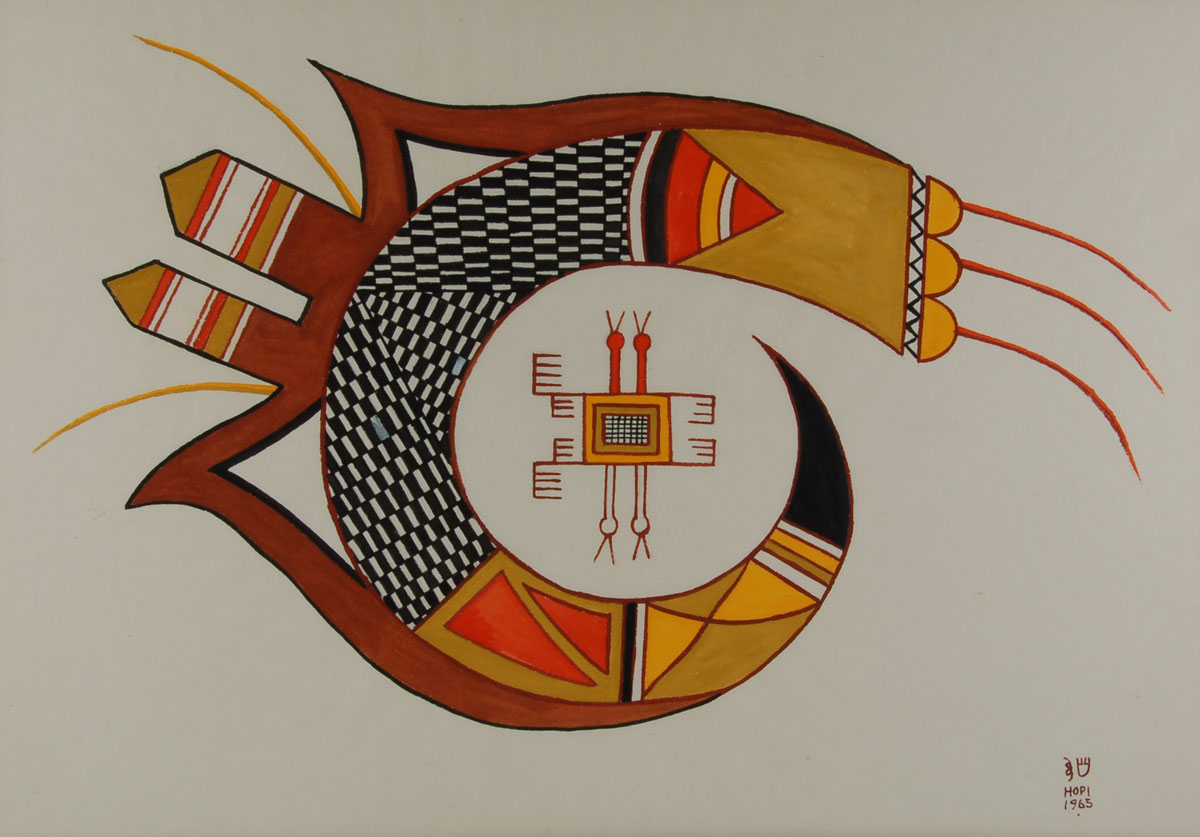 White Bear (Oswald Fredericks) spent most of his life as a Hopi artist and story teller working for various youth organizations. One of his accomplishments was the carving of the Goldwater Kachina Collection which now resides at the Heard Museum in Phoenix. His second major accomplishment was collecting oral histories of Hopi people. These oral histories were the basis of Frank Waters' Book of the Hopi.
White Bear (Oswald Fredericks) spent most of his life as a Hopi artist and story teller working for various youth organizations. One of his accomplishments was the carving of the Goldwater Kachina Collection which now resides at the Heard Museum in Phoenix. His second major accomplishment was collecting oral histories of Hopi people. These oral histories were the basis of Frank Waters' Book of the Hopi.
White Bear was born in Old Oraibi on February 6, 1905 to Charles and Anna Fredericks. He attended the Oraibi Day School, was sent to the Phoenix Indian School then on to Haskell Institute in Lawrence, Kansas, and Bacone College in Muskogee, Oklahoma. From this point he moved to New York, where he taught Indian Lore to the Boy Scouts. He then became the head instructor for arts and crafts for the YMCA in New Jersey and spent time at Shawnee-on-the-Delaware as a workshop instructor in Indian music.
Santa Clara Painting of a Pueblo Eagle Dancer by Pablita Velarde - C3565F
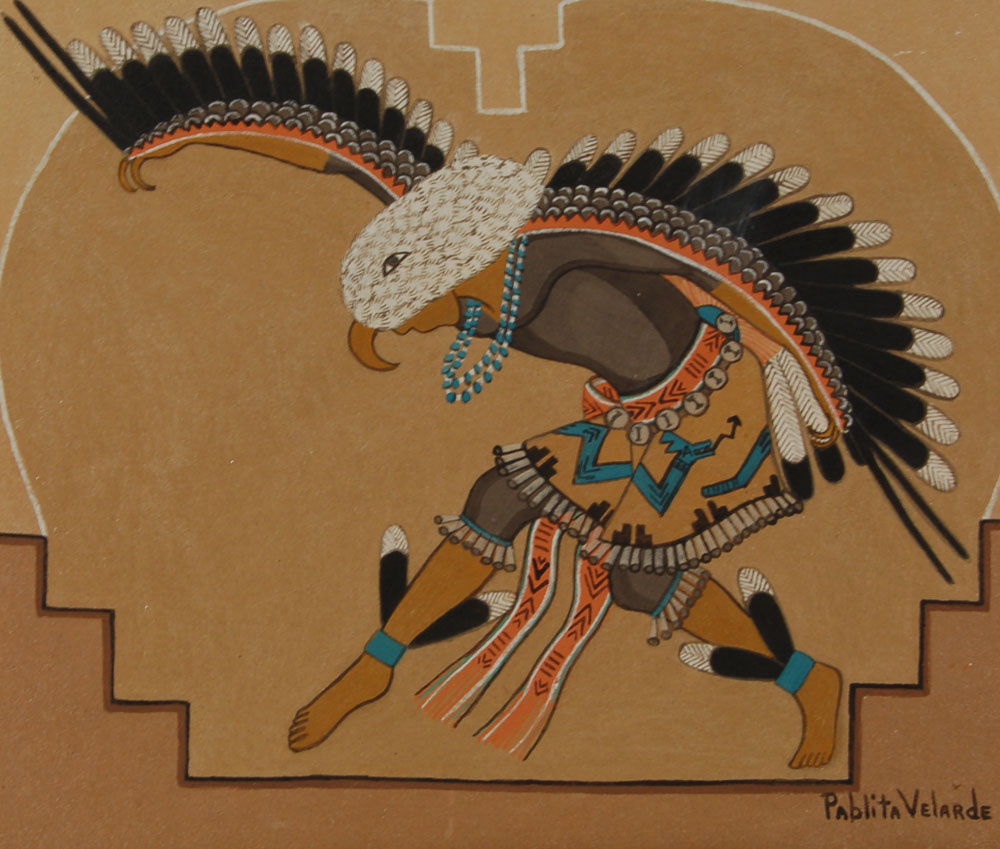 Pablita Velarde (1918-2006) Tse Tsan - Golden Dawn, Santa Clara Pueblo, was well familiar with dance costume details and she was careful to portray dancers with accurate clothing. Her paintings are ethnographically important as well as artistically important. She has provided us with a detailed representation of pueblo dancers of her time. This presentation of a very active Eagle Dancer is no exception. His costume is accurate and the presentation of the dance is as one would see at the pueblo.
Pablita Velarde (1918-2006) Tse Tsan - Golden Dawn, Santa Clara Pueblo, was well familiar with dance costume details and she was careful to portray dancers with accurate clothing. Her paintings are ethnographically important as well as artistically important. She has provided us with a detailed representation of pueblo dancers of her time. This presentation of a very active Eagle Dancer is no exception. His costume is accurate and the presentation of the dance is as one would see at the pueblo.
Encounter of a Paint Pony with a Skunk Painting by John Martinez - 25676
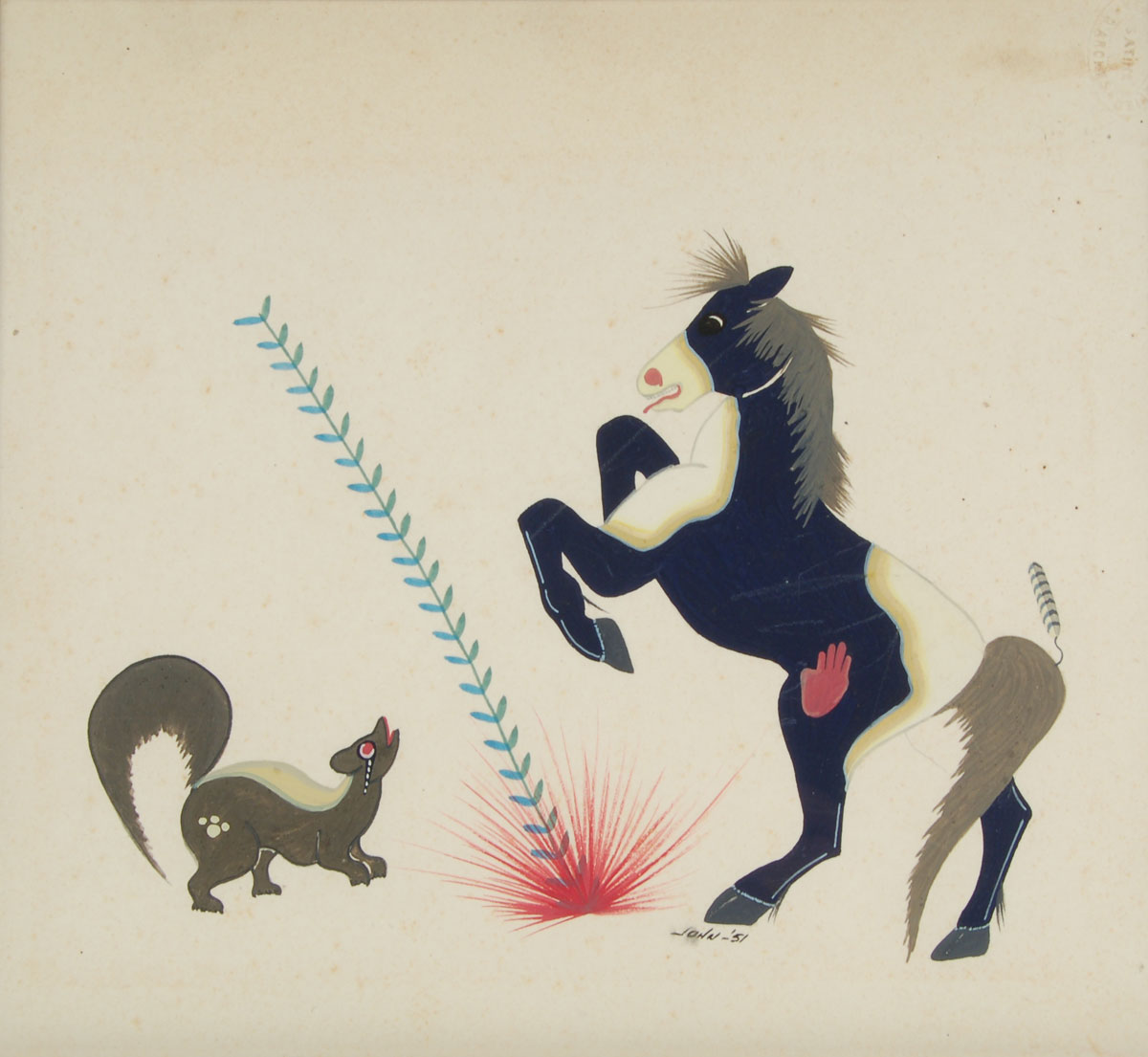 Maria and Julian Martinez had four sons: Adam, born in 1903; John in 1915; Popovi Da in 1922; and Phillip in 1925. There is very little information published on John and Phillip except a few statements made by Maria, published in Richard Spivey's book The Legacy of Maria Poveka Martinez.
Maria and Julian Martinez had four sons: Adam, born in 1903; John in 1915; Popovi Da in 1922; and Phillip in 1925. There is very little information published on John and Phillip except a few statements made by Maria, published in Richard Spivey's book The Legacy of Maria Poveka Martinez.
Acoma Pueblo Polychrome Heartline Deer Jar by Dolores Lewis - C3658D
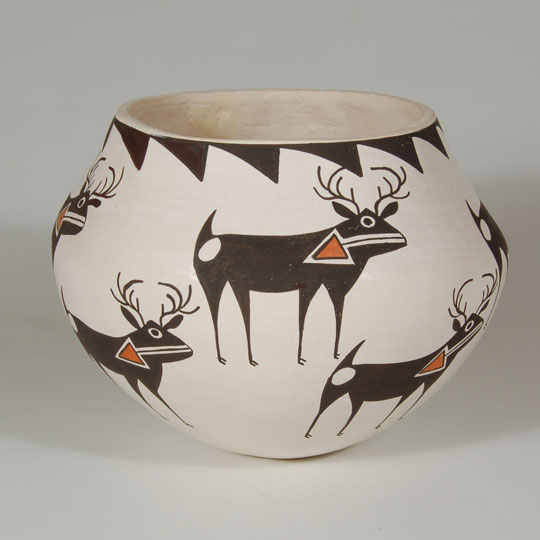 Dolores Lewis Garcia is a daughter of Lucy M. Lewis, and was taught the craft of pottery making by her mother. She says her ancient ancestors, the Anasazi, inspire her designs. The design on this jar is one generally associated with Zuni Pueblo. The figures are known as "heart-line deer." It has been stated that Lucy Lewis approached Zuni elders and asked permission to use the Zuni design on her pottery and her request was granted. She and her daughters have used the Zuni design for over a half century.
Dolores Lewis Garcia is a daughter of Lucy M. Lewis, and was taught the craft of pottery making by her mother. She says her ancient ancestors, the Anasazi, inspire her designs. The design on this jar is one generally associated with Zuni Pueblo. The figures are known as "heart-line deer." It has been stated that Lucy Lewis approached Zuni elders and asked permission to use the Zuni design on her pottery and her request was granted. She and her daughters have used the Zuni design for over a half century.

